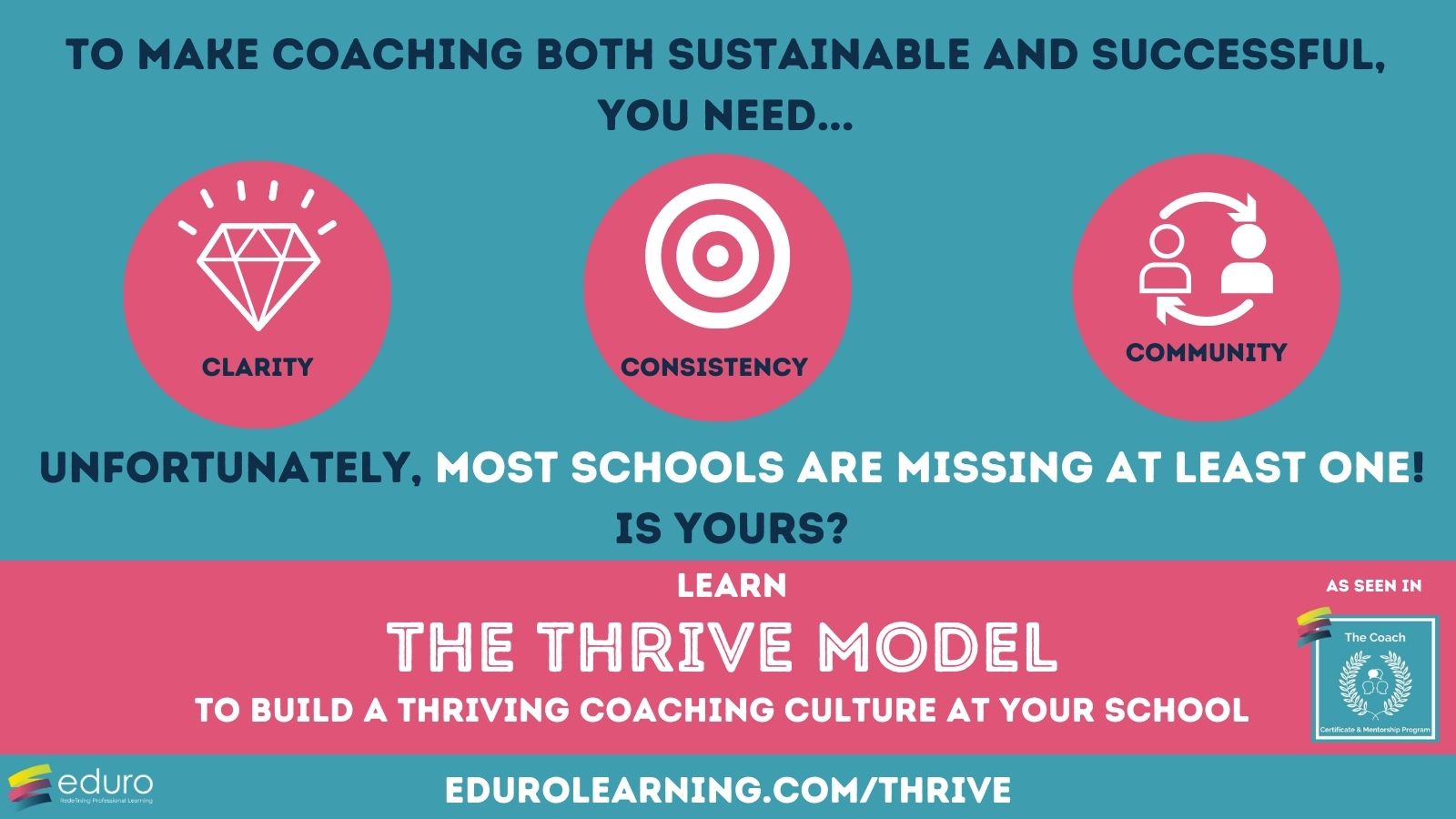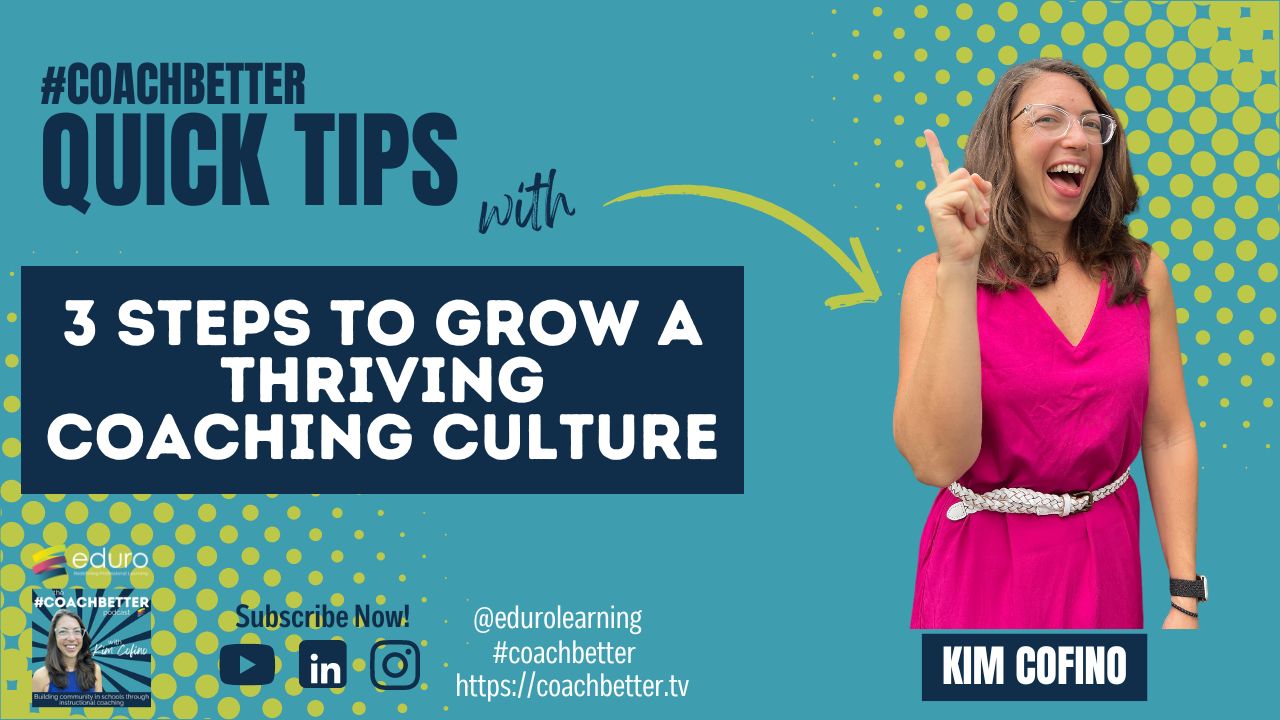It’s easy to think that once coaches are hired, and a coaching program is established, that a coaching culture will grow, but if you’ve been coaching for any length of time, you know that it doesn’t really work like that. It takes a lot of intentional and strategic work to grow a coaching culture – and you need to build in systems and structures to make it sustainable over time.
This post will share how to do exactly that – following The Thrive Model for Sustainable Instructional Coaching.
The Thrive Model brings together all of my own experience as an instructional coach and building coaching programs in many schools, as well as the experiences of my clients, and the expert guests I’ve interviewed on this podcast.
We use this model to structure all of our courses for coaches, and in particular The Coach Certificate and Mentorship Program (which opens for registration annually).
You’ll get an overview of the model in this post, and how the three elements of Clarity, Consistency and Community can be used to develop coaching programs, evaluate and refine existing programs, and support you in developing your own individual practice as a coach. With the Thrive Model we are intentionally designing for a culture of belonging through coaching with both the micro view (of your coaching practice) and the macro view (of your coaching program).
To learn more about the Thrive Model head over to our website at edurolearning.com/thrive to find out all about it – plus get access to a free webinar, our coaching program evaluation and a downloadable overview of the model, so you can start building a thriving coaching culture in your school community today!
EXPLORE THE THRIVE MODEL
Are you working on building a coaching culture in your school setting?
To make coaching both sustainable and successful, you need clarity, consistency, and community.
Unfortunately, most schools are missing at least one! Is yours?
Use the Thrive Model to find out!
Developed after working with hundreds of coaches and leaders in international schools around the world, the Thrive Model incorporates both the macro view of a coaching program, and the micro view of a coaches practice, to bring together the three essential elements to make coaching both sustainable and successful.
Explore all of our resources about the Thrive Model at edurolearning.com/thrive

Based on conversations I’ve been having in workshops, webinars, with clients and on the #coachbetter podcast, instructional coaching is on the rise in international schools – and this is wonderful and exciting!
Our schools are committed to improving student learning, and one of the most impactful ways we can do that is through instructional coaching (watch my previous #coachbetter QuickTips, Five Reasons Instructional Coaches are Essential in Schools for more on that topic).
Ultimately when teachers feel appreciated, valued, and respected in their work, it leads to “improved relationships, enhanced wellbeing, and improved teaching outcomes.” (Howells & Cumming, 2012, p. 71). One of the best ways schools can support and show appreciation for teachers is to value their professional growth and provide them the support and time they need to be successful in their roles.
However, every school, and especially each international school, is unique, based on its individual school community, host country culture, school governance, and structure, therefore there is no one-size-fits-all model of instructional coaching that will work for every international school in every context.
Introducing the Thrive Model
That’s why I developed the Thrive Model (which is grounded in the work of Joellen Killion, Cindy Harrison, Heather Clifton, Laura Lipton, and Bruce Wellman), and provides enough flexibility, and opportunity for customization, for each unique school community, while consistently leading to successful instructional coaching.
This model was developed based on my own experience developing coaching programs in multiple schools, as well as my work with clients in The Coach Certificate and Mentorship Program over the past decade. After working with hundreds of coaches, educators and leaders in schools around the world, it is VERY clear what schools (and coaches), particularly in international schools, need to ensure that instructional coaching can thrive and be sustainable over time – and that’s what I put into the Thrive Model.
The Thrive Model (which is also used as the foundation for The Coach Certificate and Mentorship Program) follows three key phases: Clarity, Consistency and Community (if you’re watching this on our YouTube channel, you can see an overview on your screen right now):
The Thrive Model for instructional coaching success (© 2023, Kim Cofino)
1: Clarity
Instructional coaching programs that are successful have clarity. With clarity comes purpose. Clarity allows us to define expectations, communicate and implement the work based on the defined expectations, and then measure the results.
Schools need clarity in terms of:
- Vision, mission and goals of the coaching program
- Defined terms for words we use (including the phrase instructional coaching)
- Philosophy and model for the coaching process
- Hiring intentions, defined roles and expectations for coaches
- Alignment with school leaders on what coaching is and is not, leaders have shared expectations of coaches
- A coaching champion at the leadership level
The success of a coaching program relies on the intentionality behind the program. Because the word “coaching” can have many definitions, the simple act of defining the word, along with the purpose of the program, can ensure that all stakeholders have a shared understanding of coaching in this particular context.
I define instructional coaching as a formal or informal process that:
- is non-evaluative and confidential (and not tied to appraisal)
- starts with teacher goals (usually for student learning) and is invitational for teachers to access
- involves a cycle, structure, or system of self-reflection
- operates close to the classroom, with observation, co-teaching, or modeling as a central part of the experience
Phrased slightly differently, instructional coaching is a structured, non-evaluative, reflective, confidential process that takes place over time, based on actual data and observation of in-classroom experiences, in partnership with the teacher and supported by an instructional coach who is also part of the school community.
When schools have a vision of a growth-minded, learning-focused organization, coaching can support that goal.
In episode 150, Laura Lipton highlights that there needs to be “a vision of learning and growth that is identical for everyone in that organization. So whenever someone is called upon to serve in their role, it should be calibrated to the vision of learning and growth,” and she recommends that as school leaders are developing a coaching program, they ask themselves “to what degree does this align with the greater vision?” (Cofino, 2022). This alignment can provide clarity in the work that coaches do, and in the structure of the coaching program.
Taking the time to intentionally structure the coaching program so that it aligns with the school’s vision provides an essential foundation to build a coaching culture, which supports the work of coaches. On another episode of #coachbetter, The Coach Mentor, Maggie Hos-McGrane said in episode 174 “people who move into a coaching role need clarity about what the job entails, and the people in the school need clarity, and the leadership need clarity. Sometimes this involves quite hard conversations with school leaders.” (Cofino, 2022). All of this requires a clear vision from the start.
Many of the challenges faced by instructional coaching in international schools might seem to be caused by things like teacher reluctance to participate, but this is very often simply the result of a lack of clarity in the development or communication of the program. As Joellen Killion said in episode 146, : “If I can describe it with specificity, it is far more likely to be achieved than if I don’t have the capacity to be specific. More time on the ‘what,’ and less time on the ‘how.’ We do that backwards in schools. We spend a lot of time on the ‘how’ without clarity on the ‘what.’” (Cofino, 2022). Spending time to develop clarity around language and purpose before taking action is essential to the establishment of a successful coaching program.
2: Consistency
Consistency clarifies expectations. When you are able to implement coaching with consistency, you can demonstrate to teachers why they might want to opt-in to coaching with you.
A consistent program looks like:
- Coaches using data from a needs assessment and regular feedback about their practice to inform their work
- The role of the coach and process of coaching is clearly and consistently communicated regularly to ensure a shared understanding
- Coaches following a similar coaching process and cycle while personalizing the experience for each teacher
- Teacher expectations of coaches are clear and the experience is repeatable for them
- Coaches are scheduled to primarily do coaching work and not other things
- Coaches are provided with professional learning opportunities to continue to develop their coaching skills
Consistency in implementation of a coaching model is the action of building trust in the coaching process. Although each coach will come to the school with their unique style, personality and expertise, following a framework allows teachers to develop an understanding of the outcome of their time spent in coaching conversations.
For teachers to invest their time in coaching, they need to have a clear understanding of what to expect. As Diane Sweeney said on episode 144: “Coaching needs to be consistent. Teachers need to know that there’s a predictable structure to this work.” (Cofino, 2022). Consistency in the coaching team ensures that teachers will have similar, although personalized, experiences, so they know what to expect when working with a coach. Personalized, consistent experiences enable teachers to recognize the value of coaching and to become comfortable with the process.
3: Community
Community grows culture. When coaches can begin to develop connections between teachers, to build capacity within the staff, they will build the foundations for a coaching culture. When schools create a culture of coaching, they are developing an environment where all educators are invested in their own professional growth and actively seek out coaching opportunities. This culture is sustained when school-supported structures and systems are implemented to create space, time and respect for the coaching process.
A thriving coaching community looks like:
- Coaching is taking place at a variety of levels: individual, team, school-wide
- Coaches are engaging in conversations about teaching and learning with a variety of stakeholders—across subject areas and grade levels, and with school leaders as well as teaching assistants
- Teachers and other educators in the community (including assistants, specialists, and school leaders) are actively seeking out coaching
- Coaches are able to build capacity among community members by connecting teachers to each other
- Data is collected regarding the impact of coaching, and the program and coaches are evaluated separately
- Both coaches and the coaching program are regularly evaluated, and the program is continually refined and communicated with all community members
- Coaching creates a sense of belonging among all stakeholders – where teachers are valued, heard, and respected for the professionals that they are, which then transfers into the classroom with students
In her experience as Middle School Assistant Principal at International School Panama, Kaitlyn Pettinga said in episode 215, “the impact of coaching is a sense of belonging,” noting that her school culture is so collaborative around teaching and learning through the work of coaching that both teachers and students feel like they belong. (Cofino, 2023). Creating a safe space for teachers to explore, take risks, and be supported in their journey, along with a deep respect for the work that teachers and students are doing, develops a sense of collective efficacy and belonging.
It is often having a personal relationship with a coach, developed and sustained over time, that can make the difference for teachers seeking to turn inspiration into action in their classroom. In an article I wrote for Learning Forward, The Learning Professional, I said: “When we invest in coaches, we are investing in teachers.” (Cofino, 2023). Coaches can help teachers feel they have someone on their side who is dedicated to their professional growth—someone embedded in their workplace who helps empower them to take action, and someone who can individualize growth experiences for them so they can apply what they’re learning.
When coaches begin to leverage the work they do with individuals to teams and groups, the culture of coaching spreads even more widely. Developing school-wide structures that support coaching (through systems like: prioritizing shared meeting times, bringing coaches into the curriculum review and planning process, and formalizing support for coaching through the schedule) are essential to sustaining a coaching culture over time.
Mind the Gap
It’s worth noting that most schools develop coaching programs organically, making progress on each of the three phases in the Thrive Model simultaneously, which can lead to potential gaps in program development.
When schools have a growth-minded community and consistency in coaching practice, but a lack of clarity around the vision for coaching, this often results in teacher reluctance to participate in coaching, or a “vision gap.”
When schools have consistency in practice and clarity in vision, but lack a growth-minded culture, this often leads to coaches working almost exclusively with the “willing” teachers and becoming stuck working at the individual (one-to-one) level, or a “growth gap.”
When schools have clarity around coaching and a growth-minded culture, but a lack of consistency among coaches or coaching practice, this often results in little to no impact from coaching, or a “consistency gap.”
These gaps can be closed through an audit or evaluation of the coaching program that intentionally addresses the missing components in each phase of the Thrive Model (find the Thrive Program evaluation on our website at edurolearning.com/thrive).
The interdependence of the components of the Thrive Model (© 2023, Kim Cofino)
Build the Foundation of a Thriving Coaching Culture
All schools with learning as their focus have the potential to build a thriving coaching culture – you just need to know what you have and what you’re missing. Building a thriving culture requires bringing the three interdependent elements of clarity, consistency, and community together – and it doesn’t really matter where you start. As long as you’re working towards defining and building clarity, consistency and community in you’re program, you’re on the right track!
If you are just beginning the journey to develop a coaching program, set yourself up for success by following the Thrive Model of Clarity, Consistency and Community. If a coaching program exists in your school, but you find yourself stuck in one of the “gaps” you can use the Thrive Model to understand where you may need to place more attention and focus.
If you’re ready to dig deeper into the Thrive Model, make sure to access all of our free resources on our website. You’ll find a free webinar, a downloadable overview of the mode and our coaching program evaluation to see where you (or your program) has opportunities for growth.
Find it all at https://edurolearning.com/thrive
And, if you discover that you need support as you go through the process, please join us for the next cohort of The Coach Certificate and Mentorship Program.
In The Coach we’ll support you in developing your coaching practice and program following the Thrive Model.
Find out more about the coach on our website at edurolearning.com/coach
As you may already know, registration opens only once a year – so make sure you get on the waiting list so you’re the first to know when registration opens again!
Get all the details, and join the waitlist, at edurolearning.com/coach
Watch the Video
Keep Learning
If you’re ready to dig deeper into being more intentional in your coaching practice – or if you’re new to instructional coaching and you’re curious about getting started, join us for one of our courses for coaches!
We have programs to support you in every stage in your journey. From new coaches moving from the classroom to a coaching role; to current coaches ready to be more intentional and strategic in their practice, to experienced coaches, ready to lead. Find them all at coachbetter.tv/learn
Free Workshops for Instructional Coaches
If you’re ready to keep learning, try one of our FREE workshops where you’ll be able to dig deeper into the concepts in this post, and get a peek at all of our courses for coaches.
We have workshops (and courses) to support coaches at every stage of their career: from new and aspiring coaches making the move from classroom to coach; to current coaches ready to be more intentional and strategic in their practice; to established coaches leveraging their coaching experience to lead.

You can them all on our coachbetter website at coachbetter.tv/workshops
If you’re curious right now, you have questions, please reach out. You can leave a comment below, join our #coachbetter Facebook group, or find us on social media at Eduro Learning and send me a DM. I’d love to support you on your coaching journey. See you next time!
Connect with us!
Subscribe to the podcast iTunes |Spotify|Stitcher
Follow us on social media: Instagram |LinkedIn
Join our #coachbetter Facebook group

Recent Comments